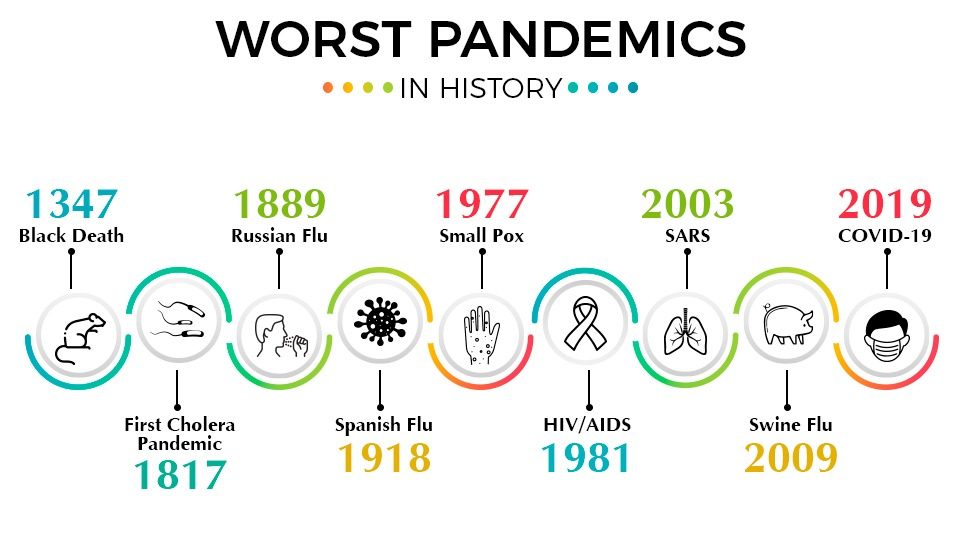Illness and diseases have afflicted humanity since the early days. The more civilised human race became, an increased level of intercontinental contact formed with different type of people & more likely pandemics occurred. When an epidemic roll outside the county’s border, the disease is called Pandemic.
Lets have a look at the biggest pandemics of history:
1347: Black Death: It has been said as the deadliest pandemic in human history. It was caused by bubonic plague. It originated in Central Asia or East Asia and carried by black rat fleas to Africa, Italian peninsula and the rest of Europe. It resulted in death of around 75-200 million people.
1817: First Cholera Pandemic – It was first of seven Cholera pandemic that were about to spread in next 150 years. It is a small intestinal infection that spread through feces infected water and food. It was spread to the regions of Spain, Africa, Indonesia, China and Japan, where it killed thousands of people. Despite its vaccine creation which happened in 1885, pandemic continued.
1889: Russian Flu – The first consequential flu that initiated in Kazakhstan and Siberia and passed on to Moscow, Finland, Poland and then to rest of Europe. It was the last pandemic of the 19th century and killed around 1 million people.
1918: Spanish Flu – It was an oddly lethal influenza pandemic that was caused by H1N1 influenza virus. It infected around 500 million people that is one third of the world’s population in four waves. The number of deaths was around 50 million and this made it one of the deadliest pandemic in the history.
1977: SMALL POX – It is a highly contagious disease which is caused by two virus types: Variola major and minor. Initial symptoms include fever and vomiting followed by rashes and bumps on the skin. It was majorly spread in people by means of contaminated objects and prevention was done by smallpox vaccine. Around 300 million people died from it during the 20th century.
1981: HIV/AIDS – It was first identified in 1981, It is a range of conditions that is caused by infection with Human Immunodeficiency Virus. Usually it is followed by a long period of no symptoms, as disease develops, there is an increased risk of developing common infections as tuberculosis etc. Treatments have been developed for delaying the progression, but there have been death of 35 million people in the world since it’s discovery.
2003: SARS – After several months of cases it was first identified in 2003, it is believed to possible originate from bats, then to cats and finally to humans in China and 26 other countries. It infected around 8000 people and caused 774 deaths. It is characterised by respiratory problems, body aches, dry cough and fever. It is spread via respiratory droplets from sneeze and cough. There are no new reported cases of SARS since 2004.
2009: SWINE FLU – it is also called as H1N1 virus and is new strain of the influenza virus that results in symptoms which are same as regular flu. It was first originated in pigs and passes on from person to person. The CDC estimates that 151,700 to 575,400 people died from that flu worldwide
2019: COVID-19 – It is an infectious disease caused by novel coronavirus which is a new coronavirus strain that has not been found in people previously. Its symptoms include fever, cough and can lead to pneumonia and death. It spreads majorly through droplets of saliva or discharge from the nose when an infected person cough or sneeze. At this time there is no specific vaccine or treatment available, however there are many ongoing clinical trials. The best way to prevent and slow down its transmission is to be well informed about same.
The views and opinions expressed, and assumptions & analysis presented in this content piece are those of the author(s) and do not necessarily reflect the official policy or position of any other agency, organization, employer or company. The information, including but not limited to, text, graphics, images and other material contained on this website are for informational purposes only. The purpose of this website is to promote broad consumer understanding and knowledge of various health topics. It is not intended to be a substitute for professional medical advice, diagnosis or treatment. Always seek the advice of your physician or other qualified health care provider with any questions you may have regarding a medical condition or treatment and before undertaking a new health care regimen, and never disregard professional medical advice or delay in seeking it because of something you have read on this website




